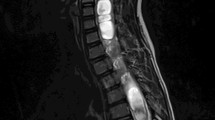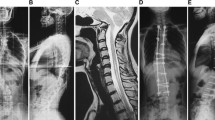Abstract
Scoliosis in childhood develops secondary to syringomyelia in some children. The existing literature does not provide a clear answer as to whether surgical treatment of the syrinx can allow subsequent improvement of the spinal deformity, thus preventing the need for scoliosis surgery. This series comprised 16 patients with syringomyelia who presented with significant scoliosis in the absence of major neurological deficit. All underwent a hindbrain decompression, and follow-up ranged from 1 to 6 years (mean 2.5 years). Subsequent deformity surgery was necessary in eight cases, but the scoliosis was seen to improve or arrest its progression in six (37.5%). Improvement was found to be statistically more likely in children of younger age at the time of syrinx surgery and in those with left thoracic curves. Improvement occurred in 71.4% of those under the age of 10 at the time of hindbrain decompression.
Similar content being viewed by others
Author information
Authors and Affiliations
Additional information
Received: 22 November 1999 Revised: 11 February 2000 Accepted: 23 February 2000
Rights and permissions
About this article
Cite this article
Sengupta, D., Dorgan, J. & Findlay, G. Can hindbrain decompression for syringomyelia lead to regression of scoliosis?. E Spine J 9, 198–201 (2000). https://doi.org/10.1007/s005860000149
Issue Date:
DOI: https://doi.org/10.1007/s005860000149




